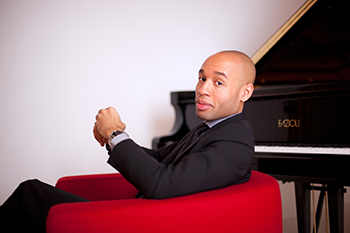by Mike Telin

But then an article about Whiteman’s planned concert ran in the New York Tribune in early January stating that “George Gershwin is at work on a jazz concerto,” which would be featured along with works by Irving Berlin and Victor Herbert. This was news to the composer, but after a phone call to the bandleader the next morning, Gershwin agreed to write the piece.
This weekend, pianist Aaron Diehl will return to the Blossom Music Center stage for performances of Rhapsody in Blue on Friday, July 5 and Saturday, July 6 at 8:00 pm with The Cleveland Orchestra. The concert, under the direction of Roderick Cox, will also include Bernstein’s Symphonic Suite from On the Waterfront, Stravinsky’s Suite from The Firebird, and Tchaikovsky’s 1812 Overture. Fireworks will follow both performances (weather permitting). Tickets are available online.
Diehl made his Cleveland Orchestra debut at Blossom in 2017 with Gershwin’s Concerto in F. “I remember the first time I played with Cleveland,” the Columbus, Ohio native said by telephone. “I remember how sensitive they were to the music and how the sections within the orchestra were so together, and so expressive and nuanced. It was like playing with a chamber music group. They were in it with me, and you know, that’s a special thing. It was a magical moment that I’ll never forget.” The pianist said that he’s excited to be returning with Rhapsody in Blue and collaborating with Roderick Cox. “I’m familiar with him but I’ve never worked with him.”
Rhapsody in Blue received its premiere on February 12, 1924 at Aeolian Hall with Paul Whiteman and his Palais Royal Orchestra and Gershwin as soloist. The concert, titled “An Experiment in Modern Music,” drew many influential musicians of the time — Sergei Rachmaninoff, Igor Stravinsky, Fritz Kreisler, Leopold Stokowski, John Philip Sousa, and Willie “The Lion” Smith were in the audience.
Diehl said that it is revealing to look at the original manuscript of the piece. “I visited the Library of Congress and they have the scores to both Rhapsody and Concerto in F. What’s interesting is that the Rhapsody is written in a two-piano score. The manuscript is impeccable — you could play from it. They also have the orchestration that Ferde Grofé did for Paul Whiteman. In that score it’s indicated that Gershwin would cue the conductor at the end of an improvised section, but it’s not in the original manuscript. There are unfinished elements in the original simply because he only had a few weeks to compose it. I don’t know how he managed to put it together in such a short amount of time. If you ask me, that’s really stunning.”
Rhapsody is a piece comprising a series of themes that are connected by solo sections during which Diehl does improvise. “Whenever the orchestra is playing and I have themes that are written in the score, I do play what’s in the score, but when they’re not playing, I try to elaborate on the themes that are written down.”
Diehl said that he’s always found it easy to connect to Gershwin’s melodic sensibilities and was first turned on to his music at a young age, when he heard pianist and composer Marcus Roberts’ 1994 album Gershwin for Lovers. “I remember listening to it when I was seven or eight. I was just mesmerized by the tunes, by Marcus’ sensibility and ensemble playing, and by how it was such a great piece of chamber art.”
That album inspired Diehl to dig further into the world of Gershwin. “I went beyond just his Tin Pan Alley tunes to Porgy and Bess and the films that feature his music, like American in Paris, which is a great work of art. I just spoke to Marcus today. He’s been an incredible influence on me, not only in terms of jazz vocabulary and conception but also in terms of playing with orchestra as a jazz musician. He was kind of the first to pave the way, especially with Gershwin’s music.”
In addition to admiring Gershwin’s music, Diehl admires what the composer did for American culture. “He understood the importance of bringing the African American folk tradition into the fine art world and how it was a crucial element of our cultural heritage. For somebody in the 1920s to bring that into the concert world was not only a novel thing, but also a fairly bold statement.”
The pianist noted that it has taken some time for Gershwin’s music to be fully embraced on the concert stage. “It’s interesting how now, in 2019, Gershwin is being celebrated as a composer — even twenty years ago his music was reserved for pops concerts. But things evolve.”
Diehl’s advice for young musicians? Learn to improvise. “I know it isn’t the norm in classical music — of course you have people like Robert Levin who is a genius at improvising — but I really encourage people to do it. It’s scary at first, but it is for everybody. It’s really about embracing any musical language — it doesn’t have to be jazz — and understanding the structure of that language, then using that to brand your own identity. I think it can apply to any form of music. And I hope that it develops even more with the synthesis between musical genres that we’re seeing today, because it can be a very beautiful thing.”
Something else he believes every musician should learn to do: compose. “Even if you’re not great at it, you should do it. It helps you understand how music is structured, and improvising is just composing in real time. And if musicians practice that skill they will be better interpreters of the standard repertoire. But that’s just my opinion.”
Photo credit: John Abbott
Published on ClevelandClassical.com July 2, 2019.
Click here for a printable copy of this article



